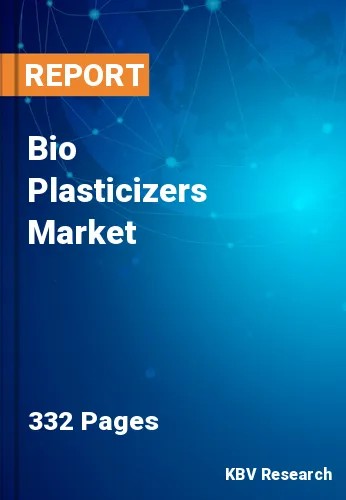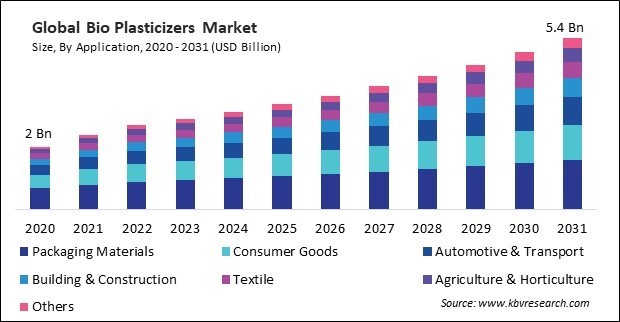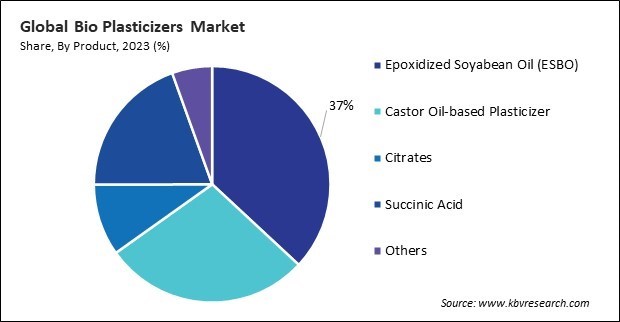
The Global Bio Plasticizers Market size is expected to reach $5.4 billion by 2031, rising at a market growth of 8.4% CAGR during the forecast period. In the year 2023, the market attained a volume of 1,682.39 Kilo Tonnes, experiencing a growth of 13.1% (2020-2023).
The versatility of bio plasticizers makes them suitable for a wide range of packaging applications. They can produce flexible films, wraps, bags, and containers, among other packaging materials. Therefore, packaging materials segment captured $915.92 million revenue in the market in 2023. Also, Russia would utilize 33.57 Kilo Tonnes of packaging materials by 2031. In addition to enhancing the processability and mechanical properties of packaging materials, these present an appealing alternative for manufacturers seeking to improve the overall performance of their packaging products.

Traditional plasticizers contribute to environmental degradation through greenhouse gas emissions, pollution, and the depletion of finite resources. This has prompted governments, industries, and consumers to seek more sustainable options. Prominent laws and initiatives around the world reflect this growing concern. Hence, the growing awareness of the detrimental effects of traditional plasticizers will support the market's growth throughout the forecast period.
Additionally, the packaging industry is experiencing a notable shift towards sustainable solutions as companies seek to reduce their environmental footprint. Increasing consumer consciousness and regulatory pressures to implement eco-friendly practices are propelling this trend. Thus, the focus on sustainable packaging solutions is driving the growth of the market as companies seek to meet consumer demands for environmentally friendly products.
However, compared to traditional plasticizers derived from fossil fuels, the production of bio-plasticizers can still incur higher expenses. This cost disparity stems from several factors, including the complexity of sourcing and processing bio-based raw materials and the need for specialized equipment and infrastructure. Hence, the high cost associated with the product may hamper the market's growth.
 Drivers
Drivers  Restraints
Restraints  Opportunities
Opportunities  Challenges
Challenges Based on product, the market is characterized into epoxidized soybean oil (ESBO), castor oil-based plasticizer, citrates, succinic acid, and others. The castor oil-based plasticizer segment procured 28.2% growth rate in the market in 2023. Castor oil is an oil obtained from the seeds of the castor oil plant (Ricinus communis). Its notable characteristic is its substantial ricinoleic acid content, rendering it well-suited for application as a plasticizer. In terms of volume, the castor oil-based plasticizer segment utilized 398.26 Kilo Tonnes Bio Plasticizers in 2023.

On the basis of application, the market is classified into packaging materials, consumer goods, automotive & transport, building & construction, textile, agriculture & horticulture, and others. The building & construction segment witnessed 10.5% growth rate in the market in 2023. These can improve the performance of building materials. They can enhance the flexibility, durability, and workability of materials such as concrete, mortar, and gypsum, making them easier to use and more resistant to cracking and other forms of damage. In terms of volume, the building & construction segment would consume 265.07 kilo tonnes of Bio Plasticizers by 2028.
Free Valuable Insights: Global Bio Plasticizers Market size to reach USD 5.4 Billion by 2031
Region-wise, the market is analyzed across North America, Europe, Asia Pacific, and LAMEA. The North America segment garnered 27.4% growth rate in the market in 2023. In North America, the demand for bio-plasticizers has been growing steadily, particularly in the construction, automotive, and packaging industries. The construction sector, for example, is increasingly using bio-plasticizers in concrete formulations to improve workability and reduce cracking. In terms of volume, Canada utilized 31.64 Kilo Tonnes Bio Plasticizers in 2020.
| Report Attribute | Details |
|---|---|
| Market size value in 2023 | USD 2.8 Billion |
| Market size forecast in 2031 | USD 5.4 Billion |
| Base Year | 2023 |
| Historical Period | 2020 to 2022 |
| Forecast Period | 2024 to 2031 |
| Revenue Growth Rate | CAGR of 8.4% from 2024 to 2031 |
| Quantitative Data | Volume in Kilo Tonnes, Revenue in USD Billion, and CAGR from 2020 to 2031 |
| Number of Pages | 332 |
| Number of Tables | 630 |
| Report coverage | Market Trends, Revenue Estimation and Forecast, Segmentation Analysis, Regional and Country Breakdown, Porter’s 5 Forces Analysis, Company Profiling, Companies Strategic Developments, SWOT Analysis, Winning Imperatives |
| Segments covered | Product, Application, Region |
| Country scope |
|
| Companies Included | Avient Corporation, BASF SE, Cargill, Incorporated, DIC Corporation, The Dow Chemical Company, Evonik Industries AG (RAG-Stifung), Lanxess AG, Solvay SA, ACS Technical Products, Emery Oleochemicals LLC |
By Product (Volume, Kilo Tonnes, USD Billion, 2020-2031)
By Application (Volume, Kilo Tonnes, USD Billion, 2020-2031)
By Geography (Volume, Kilo Tonnes, USD Billion, 2020-2031)
The Market size is projected to reach USD 5.4 billion by 2031.
Stringent regulations regarding the use of traditional plasticizers are driving the Market in coming years, however, High production costs of bio plasticizers restraints the growth of the Market.
Avient Corporation, BASF SE, Cargill, Incorporated, DIC Corporation, The Dow Chemical Company, Evonik Industries AG (RAG-Stifung), Lanxess AG, Solvay SA, ACS Technical Products, Emery Oleochemicals LLC
In the year 2023, the market attained a volume of 1,682.39 Kilo Tonnes, experiencing a growth of 13.1% (2020-2023).
The Epoxidized Soyabean Oil (ESBO) segment is registering maximum revenue in the Market by Product in 2023; thereby, achieving a market value of $1.9 billion by 2031.
The Asia Pacific region dominated the Market by Region in 2023, and would continue to be a dominant market till 2031; thereby, achieving a market value of $2.3 billion by 2031.
Our team of dedicated experts can provide you with attractive expansion opportunities for your business.
